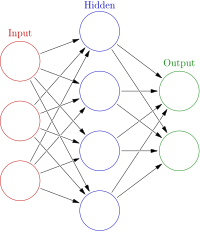
Photo from wikipedia
Short-term prediction of traffic conditions on urban arterials has recently become increasingly important because of its vital role in the basic traffic management functions and trip decision-making processes. Such information… Click to show full abstract
Short-term prediction of traffic conditions on urban arterials has recently become increasingly important because of its vital role in the basic traffic management functions and trip decision-making processes. Such information is useful for optimal infrastructure operation, routing, and trip scheduling. However, forecasting models offering a high accuracy at a fine temporal resolution (e.g., 1 or 5 min) and, especially, lane-based are still rare and need special attention. Given the dynamic and stochastic nature of traffic, this study proposes a genetically optimized artificial neural network (GA-ANN) and locally weighted regression (GA-LWR) multivariate models, for short-term traffic prediction using a combination of multiple traffic variables such as volume, occupancy, and speed, during peak and off-peak periods. The proposed 5-min GA-ANN and GA-LWR disaggregate multivariate models show lower average and 95th percentile (P95) errors, when compared to those reported in the literature. In particular, for peak and off-peak time prediction, the GA-ANN disaggregate multivariate models result in most of the average errors being from 2% to 5% and the 95th percentile errors being from 9% to 10%. On the other hand, for peak and off-peak time traffic prediction, the GA-LWR disaggregate multivariate models show that most of the average errors are lower than 5% and the 95th percentile errors are lower than 10%. Meanwhile, for peak and off-peak time prediction, both GA-ANN and GA-LWR disaggregates models show lower MSE of 0.11–1.84. Hence, such techniques are believed useful for developing a robust urban traffic forecasting system.
Journal Title: Canadian Journal of Civil Engineering
Year Published: 2019
Link to full text (if available)
Share on Social Media: Sign Up to like & get
recommendations!